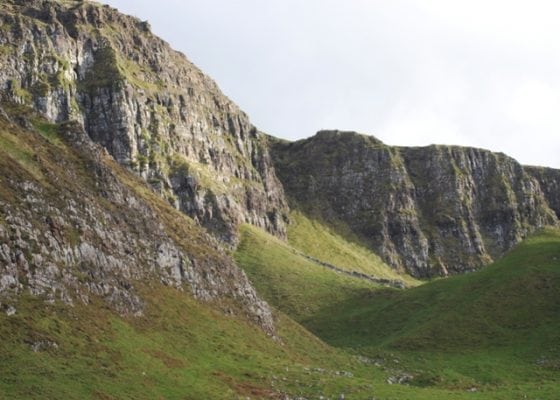- Created: August 28, 2012 10:32 am
- Updated: December 12, 2017 11:02 am
- Distance Instructions
- Distance 0 m
- Time 0 s
- Speed 0.0 km/h
- Min altitude 0 m
- Peak 0 m
- Climb 0 m
- Descent 0 m
Binevenagh is part of the northernmost outcropping of the Antrim Plateau formed when, around 60 million years ago, molten lavas poured out over the surface.
The basalt crags towering above the flat coastal plain of Magilligan are an impressive site. From the top, magnificent views of Lough Foyle and Donegal can be obtained on a clear day. Landscape features such as block slumping and scree are prominent. Most available nooks and crannies in the windswept cliffs are occupied by some hardy plants.Two of the species at Binevenagh, moss campion and purple saxifrage, are rare in Northern Ireland.
Mosses and ferns hug the more sheltered parts of the cliff face, especially the damp sides of crevices where water trickles down from above.
In early summer, the grassy slopes below show a variety of colours as harebells, thyme, kidney vetch, bird's-foot trefoil and many more take their turn to flower. Overhead you're likely to see kittiwakes, fulmars, buzzards and even a raven or peregrine falcon. From DOE
Gallery
Binevenagh is part of the northernmost outcropping of the Antrim Plateau formed when, around 60 million years ago, molten lavas poured out over the surface.
The basalt crags towering above the flat coastal plain of Magilligan are an impressive site. From the top, magnificent views of Lough Foyle and Donegal can be obtained on a clear day. Landscape features such as block slumping and scree are prominent. Most available nooks and crannies in the windswept cliffs are occupied by some hardy plants.Two of the species at Binevenagh, moss campion and purple saxifrage, are rare in Northern Ireland.
Mosses and ferns hug the more sheltered parts of the cliff face, especially the damp sides of crevices where water trickles down from above.
In early summer, the grassy slopes below show a variety of colours as harebells, thyme, kidney vetch, bird’s-foot trefoil and many more take their turn to flower. Overhead you’re likely to see kittiwakes, fulmars, buzzards and even a raven or peregrine falcon. From DOE


